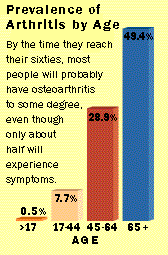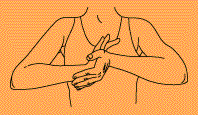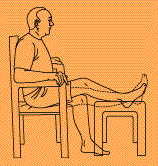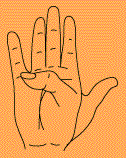Osteoarthritis can make simple tasks like holding a fork very difficult. But various coping strategies can help you get a grip on it….instead of it having a grip on you.
One in every seven Americans has arthritis, so chances are that you or someone you know has it. Arthritis, which literally means joint inflammation, causes pain and loss of movement. In fact, it can get severe enough to limit everyday activities, such as dressing, climbing stairs, getting in and out of bed or walking, for approximately 7 million Americans. Although arthritis can occur at any age, the prevalence increases dramatically after age 45.
Most people do not realize that arthritis actually refers to over 100 different varieties of joint problems that have specific symptoms, such as pain, swelling and stiffness, and treatments. Some types of the disease seem to run in families, while others appear related to chemical imbalances or immune system problems. All forms of arthritis affect the joints, but some kinds also involve the muscles and connective tissues of the body. In this article we will focus on osteoarthritis (OA), the most common type of arthritis, affecting 15.8 million people.
What is Osteoarthritis?

OA is caused by the breakdown or wearing away of cartilage, the cushion that covers the ends of bones that form the joints in our bodies. Usually the ends of the bones are affected as well. In such cases, the bone starts growing along the sides of the joint producing spurs (lumps). Each step in this process of deterioration causes pain. And although the pain may fade within a year or two, the OA doesn’t go away. The effects of this disease are often mild, but in rare cases they can be crippling. The Arthritis Foundation estimates that almost every one over age 60 probably has OA to some degree, but less than half have it badly enough to notice any symptoms.

Also known as hypertrophic arthritis and degenerative joint disease, OA can strike any joint. However, the fingers, hips, knees and spine are most commonly affected, and often the disease remains confined to one or two joints. OA is called the “wear and tear” disease because it seems to be linked to stress or trauma to the joints. That’s why athletes who sustain joint injuries and workers whose joints are challenged every day by demanding physical activity are at heightened risk of developing OA later in life.
Can Osteoarthritis Be Prevented?
There is no known way to prevent OA, but it may help to limit stress on the
joints by keeping your weight down. Researchers at Johns Hopkins Medical School
tracked more than a thousand men from youth through middle age and beyond, and
found that the heavier the guy was early on, the greater the likelihood that
the years would take an arthritic toll on his knees and hips. This study is the
first to show that even ten to 20 extra pounds in early adulthood increases
wear and tear on the shock-absorbing cartilage in the joints and can lead to
serious joint damage in the long run.
Also, avoid repetitive movements over long periods of time. If repetitive motions are an integral part of your job or leisure activities, be sure to get proper training. The less skillfully repeated actions are performed, the more likely they are to damage joints. And, if you suffer a traumatic injury to a joint, get proper medical care and rehabilitation to avoid further damage.
What Are the Symptoms of Osteoarthritis?
The symptoms of OA usually begin slowly and can seem insignificant. One or two joints may ache or feel mildly sore, especially with movement. A few people feel a constant nagging pain. Usually the symptoms are most intense after the joints have been over-used or have remained still for a long period. Sometimes a joint becomes completely stiff, but except for the hip joint, this is unusual. The muscles around the affected joint may become weak and affect a person’s coordination and posture. The pain may be felt only in the joints, in larger areas around the joint or, rarely, far from the affected area. Another fairly common sign of OA is the presence of painful bony growths in the finger joints. (Note: Knuckle cracking does not cause arthritis).
Consult your doctor if you are experiencing any of the following:
- Pain in a joint during or after use
- Discomfort in a joint before or during a change in the weather
- Loss of flexibility or swelling in a joint
- Bony lumps on the end or middle joint of the finger
A good treatment program for osteoarthritis usually includes a combination of drugs, rest, special exercises, heat and cold treatments, protection of the joints and weight control. If damage to the joint is extensive, surgery to repair or replace it may be necessary.
· Medication. Most patients are generally first treated with acetaminophen (Tylenol) because it is just as effective a pain reliever as those known as nonsteroidal anti-inflammatory drugs (NSAIDs) and has fewer side effects. However, NSAIDs are usually needed as treatment progresses because acetaminophen tends to lose its effectiveness over time. NSAIDs reduce pain and inflammation, and can be bought over the counter in products like aspirin, Advil, Aleve, Nuprin and Motrin-IB, or by prescription.
· Exercise. Exercise is a valuable treatment approach, and a doctor or a physical therapist should advise you on an appropriate program. To help prevent future problems and avoid stiffness, range of motion exercises and muscle strengthening exercises are usually recommended.
Range of Motion refers to the normal extent that your joints can be moved in all directions. If you have arthritis, you should try to move your joints through their full range of motion every day to reduce stiffness and help keep your joints flexible. A range of motion exercise for your thumb, for example, is to open your hand with your fingers straight. Stretch your thumb across your palm until it touches the base of the little finger and extend your thumb back out to the side as far as it will go (see illustration).
Keep in mind that normal every day activities, such as cleaning, climbing stairs, dressing, bathing, cooking, lifting, or bending do not move your joints through their entire range of motion. If your joints are very painful and swollen, do not forgo your exercises. Simply move them gently through their range of motion.
Strengthening exercises help maintain or increase muscle strength, which can keep your joints stable and more comfortable. Two common strengthening exercises are isometric, in which you tighten your muscles but don’t move your joints, and isotonic, in which you strengthen muscles by moving your joints (see illustrations).
· Joint Protection. Easing stress on joints is important to avoid further damage. Doctors, physical therapists and occupational therapists recommend canes, walkers or crutches for some people to help lighten the amount of body weight placed on certain joints. They may also help patients learn to use their joints in safer ways. For instance, the whole arm or the side of the body can be used to push a door open instead of the hand.
Splints may be used to keep joints from becoming permanently bent and stiff. Splints help rest joints, hold proper positions and keep muscles and ligaments around the joints limber. The Arthritis Foundation publishes an illustrated Guide to Independent Living, which describes other joint protection devices and aids and lists where they can be obtained (See For More Information).
· Rest. Too much activity can lead to increased pain and inflammation. Rest helps relieve those effects. On the other hand, too much rest may lead to stiffness and joints that move poorly. The right balance between rest and activity has to be found for each person, and that balance depends on how severe the symptoms are at any given time. More rest and less activity are needed during flares of pain and the opposite is true during periods of improvement.
· Hot or Cold Treatments. Using heat (hot baths, hot packs, heat lamps, etc.) can relax muscles and relieve pain and soreness. And cold (cold compresses, ice bags, etc.) can help numb the affected area and reduce blood circulation to alleviate pain.
· Weight Control. Excessive body weight puts unnecessary pressures on the joints and can exacerbate the condition. Doctors strongly recommend that people who are overweight lose the excess pounds through a combination of appropriate exercise and a well-balanced, low-fat diet.
· Surgery. When long-term deterioration has occurred, a surgical procedure called arthroplasty may be the best option. Total joint arthroplasty involves the actual replacement of certain parts of the joint with a plastic or metal device. All major joints now have such replacements available, but so far, artificial hips and knees have been the most successful. Joint operations are performed by orthopedic surgeons. These are doctors who specialize in bone surgery.
Living and coping with arthritis, as with any chronic disease, can be difficult. Arthritis can be mild for some people, only slightly affecting their activities. But for others, pain and other debilitating symptoms can lead to depression, anger and frustration. Don’t deny your feelings. Sharing them with your family, friends and health care professional can help you adjust to your situation. Depression and anger are normal responses that may become stronger if they are buried inside and ignored. So you can help your doctor treat your problem by explaining how you’re feeling on your medications and by describing the things that seem to make your symptoms worse. The Arthritis Foundation advises that people affected by the disease become full partners in their care. In order to do this you should take these steps:
- Understand the disease and ask your doctor as many questions as is necessary.
- Report both progress and setbacks to your physician.
- Do your exercises faithfully.
- Take your medications as prescribed.
- Get enough rest.
- Protect your joints from added stress.
- Set realistic, flexible goals.
- Find new ways to cope with physical limitations (support groups where you can talk to other people with arthritis are great for this purpose).
- Ask for help when you need it.
Our thanks to Marc C. Hochberg, M.D., M.P.H., Professor of Medicine, University of Maryland School of Medicine, Baltimore, MD, for reviewing this article.

| 1) Isometric Exercises consist of tightening your muscles without moving your joints. Example: From an upright sitting or standing position, press the palms of both hands together with all your might, as if you were trying to press communion wafers. This strengthens your arm muscles. |

| 2) Isotonic Exercises strengthen muscles by using a light weight or other resistance. Example for your thighs: Sit in a chair high enough that you can swing your leg. Keep your thigh on the chair and straighten out your knee. Hold a few seconds. Then bend your knee back as far as possible. Repeat with the other knee. |

| 3) Range of Motion Exercises reduce stiffness and help keep your joints flexible by making sure they are regularly moved the full extent of their range. Example for your thumbs: Open your hand with your fingers straight. Reach your thumb across your palm until it touches the base of the little finger. Then stretch your thumb out and repeat. |
· Personal Trainer: Exercise Programs For Your Joints
Exercise helps keep you fit and slim. If you have arthritis, it helps keep your joints, muscles and bones healthy. Exercise also gives you more energy to keep up with daily activities. However, the pain and swelling of arthritis may complicate your workout routine. The Arthritis Foundation offers various exercise programs for arthritis sufferers. You can call your local chapter for more information about where they are offered and how much each costs.
· Joint Efforts. This gentle movement and socialization activity program includes range of motion and a few strengthening exercises. All are done while the participants are seated in chairs.
· Arthritis Foundation Aquatics Program. A warm-water movement program that includes a wide variety of range of motion and muscle strengthening exercises along with an optional endurance segment.
· Arthritis Self-Help Course. This six-week series of classes features a variety of self-management topics including how to improve joint function and overall fitness through an exercise program. The course textbook The Arthritis Helpbook includes directions for over 30 different exercises.
· People with Arthritis Can Exercise (PACE). PACE is a group recreational activity program that includes games, body mechanics, relaxation techniques, and range of motion, muscle strengthening and endurance exercises. The program is available in both a basic and advanced level. PACE videotapes are also available.
You can contact the following organizations to obtain free information on arthritis:
The National Institute on Aging
Offers fact sheets geared to the needs of older people on such topics as social security, health care and exercise programs. They offer free copies of the pamphlets Arthritis Advice and Arthritis Medicine.
800-222-2225
The Arthritis Foundation
Supports research to find ways to cure and prevent arthritis and seeks to improve the quality of life of those affected by the condition. To that end, the Foundation makes free booklets available to the public, such as Using Your Joints Wisely and Exercise and Your Arthritis, which describe arthritis, medications, treatments and tips for coping with daily activities.
800.283.7800




